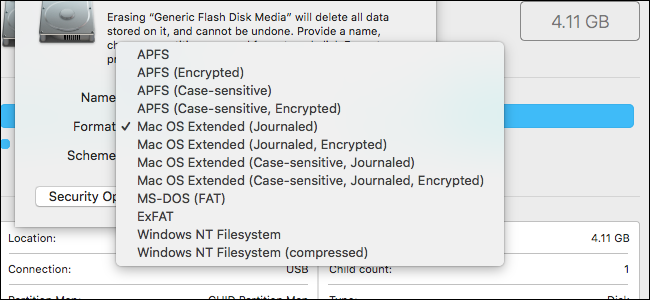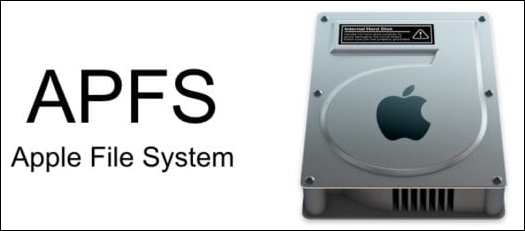What IS HFS+
HFS+ is the file system used on all Macs since 1998. It's used on all mechanical and hybrid drives. macOS older versions use it by default for all drives. HFS+ replaced its original version, Hierarchical File System (HFS), as Mac's primary file system when Apple released macOS 8.1. You can see HFS+ on Mac named Mac OS Extended (Journaled).

HFS+ vs. HFS
Compared to its predecessor HFS, HFS+ is more compatible and supports much larger files. Here's a table to show the difference between HFS+ and HFS.
| Feature | HFS | HFS+ |
| User-visible name | Mac OS Standard | Mac OS Extended |
| Number of allocation blocks | 16 bits worth | 32 bits worth |
| Long file names | 31 characters | 255 characters |
| File name encoding | MacRoman | Unicode |
| File attributes | Support for fixed-size attributes | Allows for future meta-data extensions |
| OS startup support | System Folder ID | Also supports a dedicated startup file |
| catalog node size | 512 bytes | 4 kb |
| Maximum file size | 2^31 bytes | 2^63 bytes |
HFS+ Structures
An HFS+ volume consists of nine main structures:
- Volume Header: to store volume information, such as creation date, file number, etc.
- Allocation File: to check whether an allocation block is used or free.
- Catalog File: describes the file structure on a volume.
- Attributes File: B-tree with additional fork information.
- Extents Overflow File: B-tree for the rest of the extents that the catalog file doesn't store.
- Startup File: to start up non-Mac computers.
- Alternate Volume Header: the equivalent of the HFS Alternate Master Directory Block.
- Boot Blocks: identical to the boot blocks found in HFS.
- Apple's Last sector is reserved for use during the computer manufacturing process.
HFS+ Features
To summarize, the main features of the HFS+ format are:
Efficient use of disk space: More allocation blocks mean a smaller allocation block size, especially on 1 GB or more prominent volumes, which means less average wasted space, and you can have more files as the available space can be more finely distributed among multiple files.
International-friendly file names: HFS+ uses Unicode instead of Mac OS Roman to store file names. Allowing up to 255 characters makes setting descriptive words as file names easier, and long computer-generated names are advantageous.
Future support for named forks: HFS+ has an attribute file to store additional information for files. The data can be kept with the file as it is moved or renamed and deleted when the file is deleted.
Ease booting on non-macOS operating systems: HFS+ has a particular startup file as an unstructured fork, which can be found easily during system startup. It is handy on macOS or other OS that don't have HFS/HFS+ support in ROM. It generalizes the HFS boot blocks in many respects, providing a more extensive, variable-sized storage.
HFS+ for Windows, HFS+ for Mac, HFS+ for Linux
HFS+ format files can be read/written on all Mac OS computers since macOS 8.1. But note that Windows won't recognize HFS+ format without installing third-party software, and Linux supports HFS+ format files read-only. The main advantages of HFS+ are as follows:
- Using Unicode instead of Mac OS Roman or several other character sets for naming items.
- Using B-trees to store most volume metadata.
- Supporting hard links to directories.
- Permitting file names up to 255 characters in length.
- Using a full 32-bit allocation mapping table rather than HFS's 16 bits.
- Improving the use of space on large disks.
Apple launched macOS High Sierra in 2017 and replaced HFS+ with APFS, named Apple File System, a disk format optimized for SSDs. However, HFS+ remains a popular disk format on Mac.
Note that you can't use the APFS disk as your Time Machine backup drive, and formatting disk on Mac to the HFS+ file system is a considerable choice.
Share this article on social media to read it anytime.
HFS+ vs. APFS
Apple File System is the default solid-state drive and flash memory file system in 2017's macOS High Sierra. It was first released in 2016, offering all sorts of benefits over HFS/HFS+, including:
- APFS is faster in copying and pasting a folder, and it's instantaneous because the file system points to the same data twice.
- APFS improvements to metadata mean it's rapid to determine how much space a folder takes up on your drive.
- Many reliability improvements in APFS make things like corrupted files much less common.
But note that macOS Sierra was the first operating system capable of reading and writing APFS, which means Macs with older operating systems can't write to APFS-formatted drives. If there's an older Mac you need to work with, APFS is the wrong choice for that Mac drive. And APFS vs Mac OS Extended, both can't be read/written on Windows PC.

In addition, APFS isn't compatible with Time Machine, so you'll have to format backup drives as HFS+. Otherwise, it's hard to recover files form APFS drive with Time Machine.
HFS+ vs. exFAT
The exFAT format, also called Extended File Allocation Table format, is a file system created by Microsoft in 2006. The exFAT format could be used on drives that work with Windows and macOS computers to provide cross-platform compatibility with the older FAT32 format without the file and partition size limitations.
exFAT isn't a particularly optimized format and is far more vulnerable to file fragmentation than APFS or HFS+. However, formatting a partition with exFAT offers a huge advantage: both Windows and macOS computers can read/write in this format.
The difference between HFS+ and exFAT are as follows:
| exFAT | HFS+ | |
| Primary use | File system | Mac OS file system |
| Initial release | 2006 | 1998 |
| Open format | √ | ✕ |
| Supported Operating Systems | Windows, Linux, Mac OS, Android, iOS | Linux( read-only), Mac OS, iOS |
Note that HFS+ files can't be read/written on Windows PC; if you want to use HFS+ format on Windows, you have to install third-party software like Apple HFS+ Drivers.
HFS/HFS+ Data Recovery
As the most popular disk format on Mac, HFS or HFS+ is used to save important data and files on Mac. You may lose data in some cases, such as accidentally deleting HFS/HFS+ files, HFS/HSF+ partition corruption, etc.
Most of the time, you can recover data from Trash or recover from the Time Machine on your Mac. If you couldn't recover HFS/HFS+ partition on your Mac using normal methods, I would like to introduce a data recovery software EaseUS Data Recovery Wizard for Mac.
EaseUS Data Recovery Wizard
- Recover HFS/HFS+ partition to restore lost or deleted files, including documents, photos, audio, emails, etc.
- Support data recovery for sudden deletion, formatting, hard drive corruption, and system crash under different situations.
- Support Mac NTFS partition recovery and recovery of other file system types, including HFS/HFS+.
After downloading and opening EaseUS data recovery software on your Mac, you can easily find the HFS/HFS+ partition that stored your lost data before. And the operation of HFS/HFS+ partition recovery is so easy that users without any computer experience can deal with it. You can follow three steps:
Step 1. Find the HFS/HFS+ partition you want to recover and choose to click "Scan" to find your lost data.
Step 2. View the result of scanning and select the lost data you want to recover.
Step 3. Click "Recover" and save the lost data on HFS/HFS+ partition to another secure location on Mac HD.
Conclusion
HFS+ is a file system on Mac released in 1998, and you can see it on your Mac named Mac OS Extended. It can be used on all Mac computers since macOS 8.1, while Windows can't read/write HFS+ format, and Linux can read only.
If you want to use the HFS+ format on your Windows PC, you have to install third-party software. In 2017, Apple introduced Apple File System called APFS to replace HFS+, but HFS+ is still the popular disk format on Mac.
HFS+ FAQs
If you have an HFS+ partition on your Mac, you may be confused about what HSF+ is and whether you can use an HFS+ format USB on Windows PC. Here are questions people also ask when they search for HFS+.
1. Is HFS+ the same as Mac OS Extended?
Yes. Mac OS Extended, also called HFS+, was the previous default file system for Mac drives, initially introduced in 1998. Mac OS Extended is now the default file system format on mechanical and hybrid drives from macOS High Sierra releases and later.
2. What is the use of HFS+?
HFS+ is a file system released by Apple Inc to store and organize files on Mac OS.
3. Can Windows read HFS+?
No, Windows can't read or write HFS+ format. If you want to read HFS+ format on Windows PC, installing third-party software may help.
4. Which is better, NTFS or HFS+?
The NTFS file system is famous for Windows system drives, internal HDDs, or external hard drives, while HFS+ is used on USB drives or Fusion drives on Mac OS.
Was This Page Helpful?
Brithny is a technology enthusiast, aiming to make readers' tech lives easy and enjoyable. She loves exploring new technologies and writing technical how-to tips. In her spare time, she loves sharing things about her game experience on Facebook or Twitter.
Related Articles
-
Complete Guide of SATA Cable[Definition, Types, Usage & Differences]
 Larissa/2024-02-21
Larissa/2024-02-21 -
eSATA External Hard Drive: Everything You Should Know
 Cici/2024-01-11
Cici/2024-01-11 -
How to Export Kindle Highlights, Notes and Bookmarks
 Daisy/2024-01-11
Daisy/2024-01-11 -
7 Days to Die Save File Location [Every Detail You Want to Know]
 Larissa/2024-07-01
Larissa/2024-07-01
